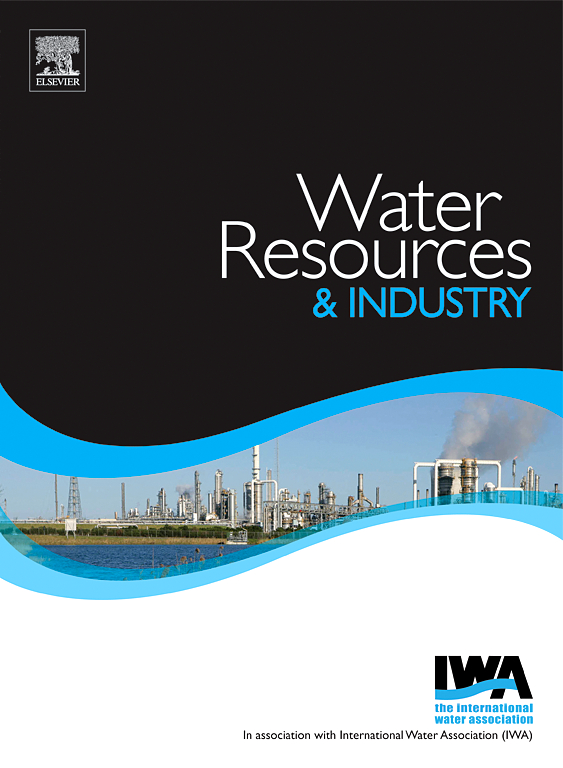基于流体动力空化和紫外辐射的四氧化剂混合工艺对紫外光降解的优化
IF 4.5
3区 工程技术
Q1 WATER RESOURCES
引用次数: 0
摘要
以过氧化氢(H2O2)和过氧二硫酸钠(PS)为化学剂,采用紫外光(UV)促进流体动力空化(HC)的四氧化剂混合工艺,研究了紫外光对紫外光红(AR)的降解。以4 L含25 ppm AR的合成AR污染废水为实验对象,采用Box-Behnken设计(BBD)对H2O2 (0-70 ppm)、PS (0-200 ppm)和UV (0-32 W)进行优化。响应面法(RSM)分析显示,HC/H2O2/PS/UV工艺的最佳条件为H2O2 41.3 ppm、PS 197 ppm和UV 31.7 W。在此条件下,脱色效率为99.23%,动力学速率常数k为80.53 × 10−3 min−1,产率为9.90 × 10−3 mg kJ−1。优化后的工艺配置在120 min内化学需氧量(COD)显著降低74.33%。基于效率成本比(ECR)对各工艺进行了技术经济分析,优化后的HC/H2O2/PS/UV工艺的ECR为398.40。为了明确活性物质的作用,在优化条件下考察了自由基清除剂的影响。加入叔丁醇和乙醇后,脱色效率分别为74.53%和53.10%,脱色速率常数分别为22.8 × 10−3 min−1和12.62 × 10−3 min−1。本文章由计算机程序翻译,如有差异,请以英文原文为准。

Optimizing a quad-oxidant hybrid process based on hydrodynamic cavitation and UV radiation for Allura red degradation
This research investigated Allura Red (AR) degradation using a quad-oxidant hybrid process with hydrodynamic cavitation (HC) promoted by ultraviolet radiation (UV) in combination with sodium peroxydisulfate (PS) and hydrogen peroxide (H2O2) as chemical agents. The experiments were carried out for 4 L synthetic AR-polluted wastewater containing 25 ppm AR. Optimization was performed using a Box-Behnken design (BBD) with H2O2 (0–70 ppm), PS (0–200 ppm), and UV radiation (0–32 W). Response surface methodology (RSM) analysis revealed optimal conditions for the HC/H2O2/PS/UV process as 41.3 ppm H2O2, 197 ppm PS, and 31.7 W UV power. Under these conditions, 99.23 % decolorization efficiency with a kinetic rate constant (k) of 80.53 × 10−3 min−1 and yield efficiency of 9.90 × 10−3 mg kJ−1 was achieved. The optimum configuration also resulted in remarkable 74.33 % reduction of Chemical Oxygen Demand (COD) within 120 min. Techno-economic analysis, based on the efficiency-cost ratio (ECR) was conducted on all processes revealed that the ECR of the optimized HC/H2O2/PS/UV process was attained at 398.40. To clarify the role of reactive species, the influence of radical scavengers was investigated under the optimized conditions. Decolorization efficiency was reduced to 74.53 % and 53.10 % with the addition of tert-butanol and ethanol, respectively, with corresponding rate constants of 22.8 × 10−3 min−1 and 12.62 × 10−3 min−1.
求助全文
通过发布文献求助,成功后即可免费获取论文全文。
去求助
来源期刊

Water Resources and Industry
Social Sciences-Geography, Planning and Development
CiteScore
8.10
自引率
5.90%
发文量
23
审稿时长
75 days
期刊介绍:
Water Resources and Industry moves research to innovation by focusing on the role industry plays in the exploitation, management and treatment of water resources. Different industries use radically different water resources in their production processes, while they produce, treat and dispose a wide variety of wastewater qualities. Depending on the geographical location of the facilities, the impact on the local resources will vary, pre-empting the applicability of one single approach. The aims and scope of the journal include: -Industrial water footprint assessment - an evaluation of tools and methodologies -What constitutes good corporate governance and policy and how to evaluate water-related risk -What constitutes good stakeholder collaboration and engagement -New technologies enabling companies to better manage water resources -Integration of water and energy and of water treatment and production processes in industry
 求助内容:
求助内容: 应助结果提醒方式:
应助结果提醒方式:


